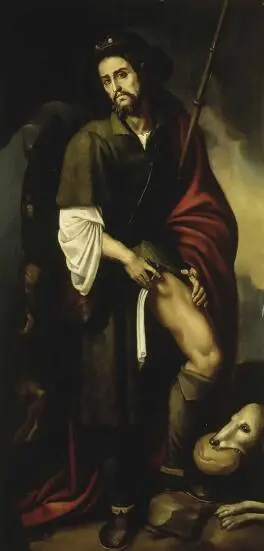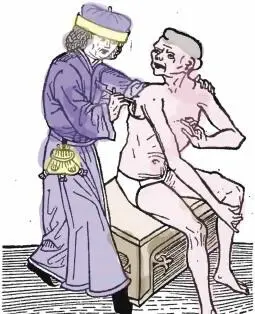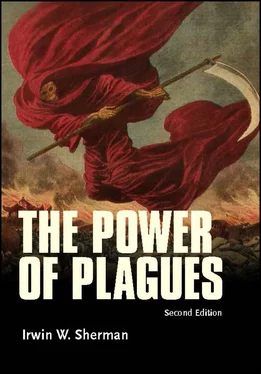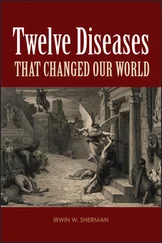In cities of 50,000 people, more than 500 died each day. Priests who gave last rites had a very high mortality rate, and there was a loss of faith in the clergy because they seemed so powerless to prevent death or the spread of death from disease. There was also a decline in papal authority. The Church passed the responsibility for plague on to God, suggesting that this was Judgment Day, that people had sinned and so nothing could be done to reduce the suffering. All of the monks of a monastery near Avignon and another near Marseilles succumbed.
Fear of plague also led to a greater consciousness of religion, especially the “magical religion” embodied in the cults of healer saints. These patron saints, who not only knew suffering but also had the power to heal the sick and provide comfort, usurped the veneration of God alone and set the stage for long and divisive debates over the nature of religion. One of these healer saints was St. Sebastian, and another was St. Roch ( Fig. 4.3). Although it is not known whether the life of St. Roch is truth or fiction, his story comes to us in written form in 1414 from the Venetian humanist and scholar Francisco Diedo. Roch was born in Montpellier, France, in 1295, and he is said to have had a birthmark in the form of a red cross on his breast. As a young man he gave to the poor and embarked on pilgrimages to Rome. Wherever he traveled there was plague, and he was able to cure the afflicted by placing his hands on the buboes. He eventually contracted the disease, was expelled from Montpellier, and died in 1327. St. Roch is often depicted as a pilgrim carrying a purse and a staff and pointing to a bubo on his inner thigh.

Figure 4.3St. Roch, the patron saint of those suffering from plague. The original hangs in the Galleria Dell’ Academia, Venice, Italy, Courtesy Wikipedia.com
Another threat to the Church was a pilgrim movement of another sort. The Brethren of the Flagellants began in eastern Europe, but its strongest bases were in Germany and France. The flagellants, sometimes as many as a thousand, marched in procession through the town; they were led by a master carrying a banner of purple velvet and were dressed in cloth of gold. Masked and dressed in dark clothing emblazoned with a red cross, each flagellant carried a whip made of leather thongs and tipped with metal studs, with which they beat their backs and chests. (This is graphically shown in Goya’s painting of the flagellants as well as in Ingmar Bergman’s movie The Seventh Seal .) The flagellants were a counterculture to the Church, and they claimed divine authorization for their mission, the alleviation of the plague. Pope Clement VI initially encouraged the flagellant movement, and up until 1349 the flagellants had their way in recruiting other pilgrims, but when the pope saw he could not control it, he issued a bull denouncing the movement and its practices. Eventually the movement ceased for reasons not fully understood. In its time, however, the flagellant movement did some good: it brought about a spiritual revival, sinners confessed and robbers returned stolen property, hope was raised (albeit temporarily), and it provided a theatrical diversion. But in the final analysis, the movement did more harm than good. Jews became the special victims of the flagellants, and their persecutions were the forerunners of the pogroms. In Frankfurt in 1349 the flagellants rushed into the Jewish quarter and incited the people to engage in wholesale slaughter. In Brussels the mere announcement of their arrival triggered a massacre of 600 Jews. Death from the Black Death itself coupled with that due to virulent anti-Semitism virtually wiped out Jewish communities in many parts of Europe and also led to permanent shifts in their populations to Poland and Lithuania.
Medicine was also affected. Medieval society had four kinds of medical practitioners: academic physicians, who knew theory but did not care for the sick; surgeons, who learned their trade as apprentices and who were the principal caregivers of the sick; barbers, who did bloodletting and minor surgery; and those who practiced folk medicine, mostly women. Academic physicians were generally older men who relied on the teachings of Galen, who believed, as did Hippocrates before him, that disease was a result of an imbalance in the four humors of the body (blood, phlegm, and black and yellow bile). But since plague appeared to have little to do with humoral changes, confidence in the academic physicians diminished. When these holders of the chairs of medicine at the great European universities died, the newer and younger appointees could move into other clinical areas, such as anatomy. Surgeons, who wore a costume with a beak containing perfume or spices, a cloak of waxy leather, eye lenses, and a wand with incense ( Fig. 4.4), and who cared for the sick, died at higher rates than did the other medical practitioners. Because of this, their role in curing disease was little valued. Indeed, the stench of death was so great during the plague years that to “purify” the air, the perfume Eau de Cologne was invented in Germany and named after the city of Cologne. Today, the perfume is known as “4711,” the address of the household where it was first made. New prestige fell to the barbers, and bloodletting and surgery ( Fig. 4.5) became an integral part of their practice rather than barbering alone. This also led to an emphasis on studies of human anatomy in health and disease, and the Galenic system, which had no clear theory of contagion, declined in importance. Slowly, very slowly, change occurred both in the thought and in the practice of medicine, and it was the Black Death that instigated that change.
One of the first physicians to advance a theory of contagion was Giovanni Fracastoro (1483-1533), in his book On Contagion and Contagious Diseases . Infectious disease, Fracastoro wrote, could be transmitted by semenaria (“germs”) in three ways: by direct contact, through carriers such as dirty linen, and through airborne transmission. His theory was put into practice when as physician to Pope Paul III he recommended the transfer of the Council of Trent from Trent to Bologna as a response to plague. Other physicians, however, did not subscribe to Fracastoro’s theory, and soon the practices were displaced by misguided suggestions until they were revived in the 19th century by Louis Pasteur, Robert Koch, and their associates.

Figure 4.4Dr. Pestis, the plague doctor in costume, Courtesy Wikipedia.com

Figure 4.5A barber-surgeon lancing a bubo. Woodcut
As the death toll from the plague increased, the numbers of learned individuals decreased. This affected the universities, where lawyers, physicians, and clerics were trained. As the numbers of university students declined, so too did the number of universities. Before 1348 all of Europe had 30 universities, but by the time the plague ended 5 of these had been wiped out completely. The institution of cordons sanitaires as well as other restrictions on travel prevented students from enrolling at distant universities, and so local universities were established. Cambridge University in England acquired four new colleges, each founded by a bequest of a rich and pious patron, and all benefiting poor local scholars and clerics. Similarly, new universities were established throughout Europe in cities such as Vienna, Prague, and Heidelberg, so that it no longer became necessary to travel to Bologna or Paris for an education. This not only diminished the dominance of certain centers of learning but also led to curricular reform, and instruction began to be carried out in the vernacular tongue.
Читать дальше















